Callosal connections of dorsal versus ventral premotor areas in the macaque monkey: a multiple retrograde tracing study
- PMID: 16309550
- PMCID: PMC1314896
- DOI: 10.1186/1471-2202-6-67
Callosal connections of dorsal versus ventral premotor areas in the macaque monkey: a multiple retrograde tracing study
Abstract
Background: The lateral premotor cortex plays a crucial role in visually guided limb movements. It is divided into two main regions, the dorsal (PMd) and ventral (PMv) areas, which are in turn subdivided into functionally and anatomically distinct rostral (PMd-r and PMv-r) and caudal (PMd-c and PMv-c) sub-regions. We analyzed the callosal inputs to these premotor subdivisions following 23 injections of retrograde tracers in eight macaque monkeys. In each monkey, 2-4 distinct tracers were injected in different areas allowing direct comparisons of callosal connectivity in the same brain.
Results: Based on large injections covering the entire extent of the corresponding PM area, we found that each area is strongly connected with its counterpart in the opposite hemisphere. Callosal connectivity with the other premotor areas, the primary motor cortex, prefrontal cortex and somatosensory cortex varied from one area to another. The most extensive callosal inputs terminate in PMd-r and PMd-c, with PMd-r strongly connected with prefrontal cortex. Callosal inputs to PMv-c are more extensive than those to PMv-r, whose connections are restricted to its counterpart area. Quantitative analysis of labelled cells confirms these general findings, and allows an assessment of the relative strength of callosal inputs.
Conclusion: PMd-r and PMv-r receive their strongest callosal inputs from their respective counterpart areas, whereas PMd-c and PMv-c receive strong inputs from heterotopic areas as well (namely from PMd-r and PMv-r, respectively). Finally, PMd-r stands out as the lateral premotor area with the strongest inputs from the prefrontal cortex, and only the PMd-c and PMv-c receive weak callosal inputs from M1.
Figures

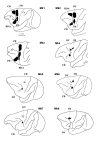

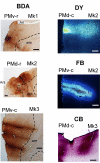
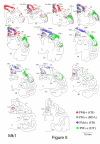
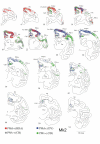
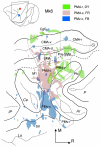

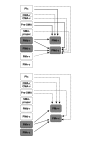
References
-
- Kurata K, Hoffman DS. Differential effects of muscimol microinjection into dorsal and ventral aspects of the premotor cortex of monkeys. J Neurophysiol. 1994;71:1151–1164. - PubMed
Publication types
MeSH terms
Substances
LinkOut - more resources
Full Text Sources
Molecular Biology Databases

